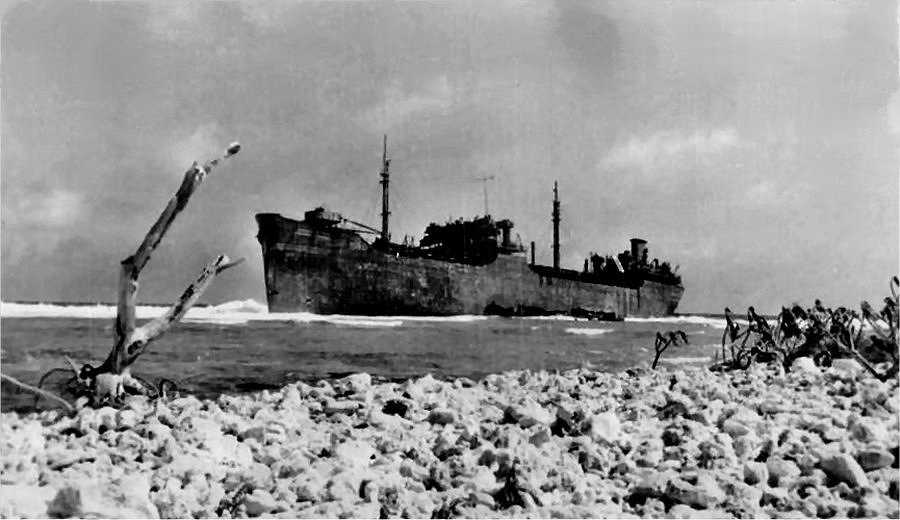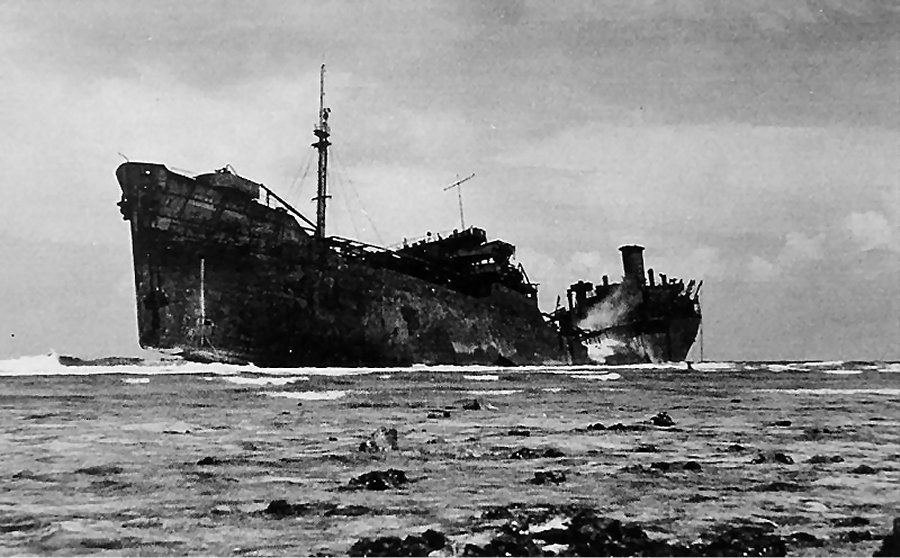Auke Visser's Famous T - Tankers Pages | home
Nickajack Trail
T2-SE-A1
"Nickajack Trail", stranded at Japtan Island near Eniwetok.
( Photo Copyright Reserved )
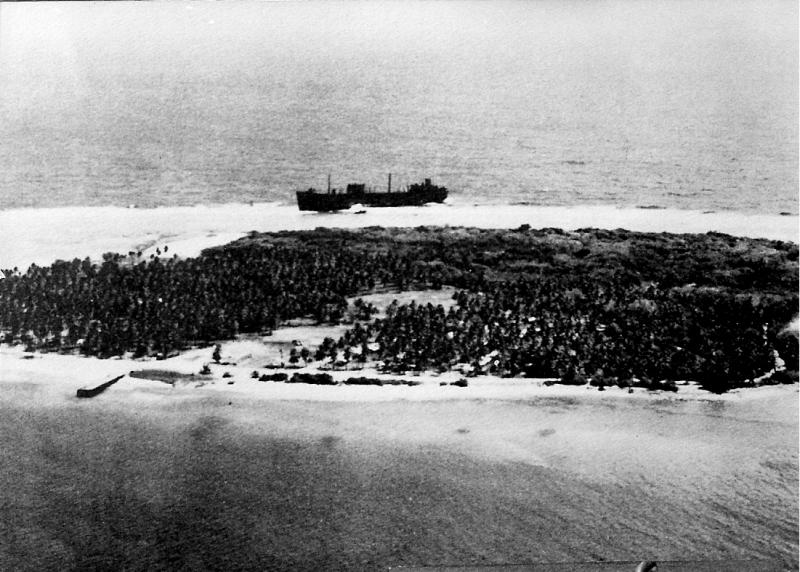
"Nickajack Trail", stranded at Japtan Island near Eniwetok.
( Photo Copyright Reserved )
"Nickajack Trail", stranded at Japtan Island near Eniwetok, falling apart.
( Photo Copyright Reserved )
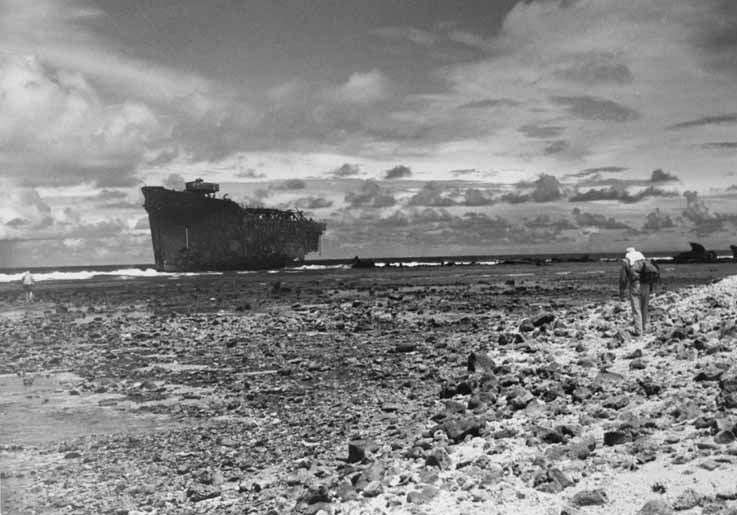
"Nickajack Trail", stranded at Japtan Island near Eniwetok.
( Photo Copyright Reserved )
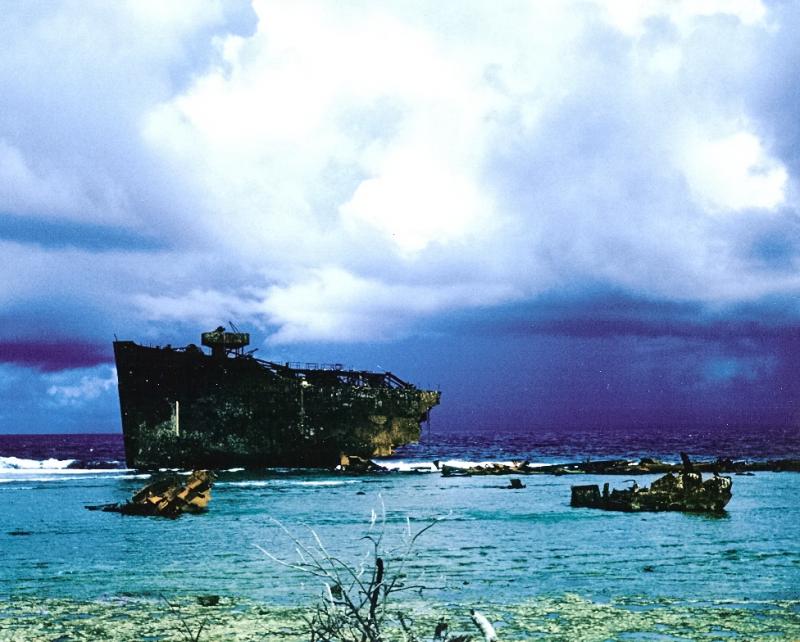
"Nickajack Trail", stranded at Japtan Island near Eniwetok.
( Photo Copyright Reserved )
NICKAJACK TRAIL, T2-SE-A1
History :
Built by The Kaiser Co., Swan Island Yard, Portland, Oregon.
Yardnumber 70. UMSC No. 1927. Off. nr. 245887.
Keel laid 12-04-1944. Launched 16-05-1944. Completed 23-06-1944. Gr. 10448 t., Net. 6285 t., Dw. 16613 t. L.o.a. 159,57 m., Br. 20,78 m., Dr. 8,99 m. Engine: 2 steam turbines, manufactured by General Electric Company, Lynn, Massachussetts. 7240 B.h.p., 5401 kW. Speed 15 knots. 26 Tanks.
History:
NICKAJACK TRAIL-1946 for United States War Shipping Administration, Portland, Oregon, USA.
Additional Reports:
Reported Nickajack Trail grounded and sank 30 Mar. 1946 at Eniwetock Harbour Entrance. Voyage Port Arthur-Yokohama, fuel oil.
|
Source : Dick Dunlap - Location: Eniwetok Atoll Marshall Islands - Year: 1946
The Nickajack Trail Revisited
When I first saw the ship on the reef at Japtan Island at Eniwetok Atoll, I was in awe of its size and complexity. What missions had it accomplished? Where had it been? Why was it wrecked? Where are the men of its crew? How can we abandon 16,000 tons of steel as if it were a used up tin can? The answers were not readily available. The service men on our atoll were rotated every year, which left no eye witnesses to tell the story. The truth was distorted by the stories of 6 generations of men coming and going.
56 years later I wrote my story of the Nickajack Trail for a newsletter of Air Force Weathermen who had been stationed on the island at the same time I had visited the ship. The Editor of the newsletter politely questioned the authenticity of my facts because he had a different story regarding the ship. My story was published and subsequently posted on the Internet. Then the E-mails poured in.
“The ship on the reef was really a Japanese freighter bombed during the war.”
“The ship was a Japanese aircraft carrier caught escaping the atoll during the 1944 invasion.”
“The ship was an American freighter stuck by Japanese artillery during the invasion and purposely grounded to save the crew.”
I knew none of this was true. I had been on the tanker and had documents which showed her to be American and in service during 1945. This started my search of Internet records of the Nickajack Trail.
She was a T-2 tanker built at Swan Island near Portland, by the famed Kaiser Co. and completed in June of 1944. The T-2 Tankers were similar to Liberty or Victory ships, but built to carry liquid petroleum products, primarily oil and gas. The 24 hour - 7 day a week production at the shipyards could complete a tanker in 70 days. The 1st tanker was completed in December of 1942. By wars end in 1945, an unbelievable 143 T-2 tankers were built at Swan Island. The Nickajack was #70.
A T-2 tanker was 523 feet long and 68 feet at the beam. (Navy talk for wide) It could travel at the relatively slow speed of 16 knots. (Navy talk for about 17 miles per hour) And carried up to 6 million gallons of gas and petroleum in 9 large tanks built into the center of the ship. They typically carried a crew of 43 and during the war, 17 navy armed guard to operate the deck gun.
I could find no records of Nickajack Trail’s travels during the final years of the war, but reports I found on board showed she was sailing the Central Pacific in October and November of 1944.
The records now skips to March of 1946 and involves 2 Japanese war ships, the older battleship Nagato and a relatively new light cruiser Sagawa. Both were selected to be target ships at the atomic bomb test to be held at Bikini Atoll. They sailed from Yokosuka, Japan with an American crew. Both ships were in deplorable condition, overrun with bilge rats and nonfunctioning equipment. On the Nagato only two of the four screws functioned and leaks occurred filling some compartments causing listing and slowing the progress.
300 miles from Eniwetok the Sagawa broke down and the Nagato set a tow line but then blew a boiler and ran out of fuel. The Nickajack Trail en route to Yokohama was diverted to refuel the Sagawa and Nagato but attempting to enter Eniwetok lagoon, runs aground on a reef and is lost. Military efficiency at its worst.
A side note -- Five members of the Sagawa’s American crew sabotaged the ships fuel system in hopes of putting the ship out of commission and being relieved of duty from the filthy warship, but they were instead brought up on charges of willful stranding or injury of vessels of the navy, a crime punishable by death under some circumstances.
Another side note -- Both the Sagawa and the Nagato kept their appointment for the atomic tests at Bikini and both presently lie on the bottom of the Bikini lagoon with dozens of other ships. However, if ships can feel they probably take solace in the fact they were responsible for one last sinking -- the Nickajack Trail. Also the five crew member saboteurs from the Sagawa were court marshaled and given sentences considerably lighter then death.
A few years ago I received an E-mail from a veteran who had been on Japtan Island in 1962. He was familiar with the hulking bow of the Nickajack Trail on the reef. A month before he rotated the ban on personal cameras was rescinded. He took the above picture and has had it hanging behind his desk for the last 45 years. He most graciously had it copied and now I have hung that picture by my computer.
The latest chapter in my search for facts was an E-mail from a lady who had read my account and wondered if I had known her father, a Harold Taylor, who was a crew member when the Nickajack Trail met its demise. She was in the process of writing her Mother and Fathers memories for her family, and wondered if I could add any facts to her Fathers account which she included.
Harold sounds like my kind of guy with a wild sense of humor. His account tells of a trip through the Panama Canal and beautiful weather until they got to the Marshal Islands.
“We came in on the right hand side of a red buoy. (Your supposed to come on the left side of a red buoy.) But no we come in on the right hand side. I was up on bow watch and I called the wheelhouse and said ‘Hey man, there’s a coral reef just ahead of us. Man, can’t you see that damn rock! We’re goin hit it.’
‘ya, we can see it, we can see it.’
‘I had to wrap my legs around a machine to keep from being thrown overboard! We went right up on that damn reef and ripped the bottom out of the tanker, out like a wet paper bag!
‘The Captain tried to lighten the load and pump air in the hull to float us off the reef. Finally after several weeks a navy Admiral came on board and ordered everyone off the ship.’
A Hawaiian newspaper reported the ship sunk and all hands lost. A few weeks later the entire crew arrived in Honolulu fit and alive. At a hearing in San Francisco, Captain John Lind, Skipper of the Nickajack Trail had his license suspended for three months.
Isn’t the Internet miraculous? What a wealth of information. If there is a lesson from all this it is to remember as we go through life, keep on the left side of a red buoy. Or is that the right side?
|
